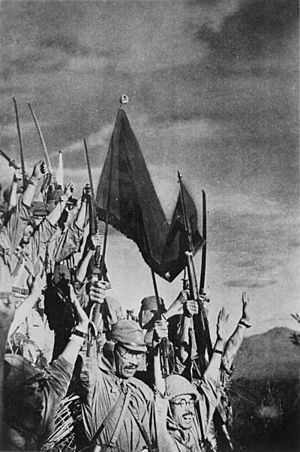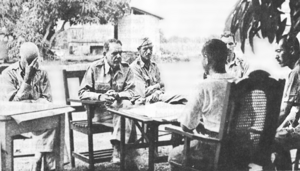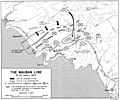Battle of Bataan facts for kids
Quick facts for kids Battle of Bataan |
|||||||
|---|---|---|---|---|---|---|---|
| Part of World War II, Pacific theater | |||||||
 Japanese soldiers celebrate victory on Bataan |
|||||||
|
|||||||
| Belligerents | |||||||
| Commanders and leaders | |||||||
| Strength | |||||||
| 79,500 U.S. and Filipino troops | 75,000 Japanese troops | ||||||
| Casualties and losses | |||||||
| 115,000 10,000 killed, 20,000 wounded, 75,000 prisoners |
19,000 7,000 killed, 12,000 wounded, |
||||||
The Battle of Bataan was a major fight during World War II. It happened when Japan invaded the Philippines. Japan wanted to take over the Philippines. This was part of their plan to control the Southwest Pacific. They also wanted to get valuable resources from places like the Dutch East Indies.
This battle ended with the largest surrender of American and Filipino soldiers ever. It was a very tough time for the troops involved.
Contents
Japan Attacks the Philippines
On December 7, 1941, Japanese planes attacked the United States Pacific Fleet at Pearl Harbor. The very next day, Japanese aircraft also bombed important American air bases near Manila in the Philippines. Many American planes were destroyed.
The U.S. Asiatic Fleet moved its ships away from its naval base. Only the submarines stayed to fight the Japanese. From December 8 to 10, Japan quickly captured several airfields. American planes tried to fight back, damaging some Japanese ships.
The main Japanese attack on the Philippines began on December 22, 1941. The 14th Japanese Imperial Army, led by Lieutenant General Masaharu Homma, landed troops.
War Plan Orange-3
The Japanese forces quickly attacked after landing on the beaches. The American commander, General Douglas MacArthur, saw that their beach defense plan was not working.
On December 26, he decided to use War Plan Orange-3 (WPO-3). This plan was designed to defend only Bataan and Corregidor. The goal of WPO-3 was to slow down the Japanese. This would give the U.S. Pacific Fleet time to reach the Philippines and help.
Manuel L. Quezon, who was the president of the Philippines, and his family moved to Corregidor for safety. General MacArthur's headquarters also moved there.
The Retreat to Bataan
General MacArthur wanted to move his soldiers to stronger defensive positions. The untrained Philippine Army troops defending the beaches were quickly defeated by the Japanese attack.
The U.S. forces decided to fight at a place called Layac. This was to slow down the Japanese troops. From January 1 to 5, 1942, the U.S. fought hard. This allowed their troops to pull back safely to Bataan.
War Plan Orange-3 included two main defensive lines across the Bataan Peninsula.
Fighting on the Defensive Lines
On January 9, Japanese forces attacked the eastern side of the Abucay-Mauban line. American troops fought them off. The Japanese then advanced to the Salian River valley, but U.S. troops again stopped their attack.
To the west, another Japanese force managed to get past the Abucay-Mauban line. However, the U.S. stopped their advance there too. On January 15, one Philippine division was bombed but held their position.
The Japanese found a gap and moved through it. Because of this, the Abucay-Mauban line had to be left on January 22. Within four days, a new line was formed, called the Orion-Bagac line.
General Homma then ordered his forces to stop fighting for a while. He needed to reorganize his troops. On February 22, the Japanese army pulled back a few miles to the north.
Japanese troops also landed on the west coast of southern Bataan on January 22. The U.S. sank two of their barges. The remaining Japanese forces split into two groups. Philippine and U.S. Army Air Corps soldiers, fighting as infantry, stopped them. Japanese commanders sent more troops, but they could not break through.
The Fall of Bataan
On the night of March 12, General MacArthur and his family left Corregidor. MacArthur went to Australia. He famously promised the Filipino people that he "shall return."
After their first attack on Bataan failed, the Japanese sent many more artillery forces to the Philippines. They had 190 artillery pieces, including very large cannons. They also sent new troops to General Homma's 14th Imperial Army. By the end of March, the Japanese were ready for their final attack.
On April 3, the Orion-Bagac line was heavily bombed by 100 aircraft. Three hundred artillery pieces also shelled the line. The Japanese 65th Brigade and 4th Division attacked the left side of the American II Corps.
By April 8, the senior U.S. commander on Bataan, Maj. Gen. Edward P. King, decided to surrender. The next morning, April 9, 1942, General King met with Maj. Gen. Kameichiro Nagano. The tired and starving American and Filipino defenders on the Bataan peninsula surrendered.
Legacy of Bataan
April 9, the day Bataan fell to the Japanese, is a national holiday in the Philippines. It was once called Bataan Day. Now, it is known as Day of Valor or Araw ng Kagitingan. This day remembers both the Fall of Bataan and the Fall of Corregidor.
The Dambana ng Kagitingan (Shrine of Valor) is a war memorial built on top of Mount Samat. The memorial has a large colonnade with an altar and a museum. At the very top of the mountain is a memorial cross, standing about 311 feet (95 meters) high.
Two ships in the United States Navy have been named after Bataan. The USS Bataan (LHD-5), an Wasp-class amphibious assault ship, was launched in 1997. The USS Bataan (CVL-29), an Independence-class aircraft carrier, was launched in 1943 and served until 1954. Both ships honor those who fought and sacrificed in the Philippines.
The Bataan Death March Memorial Monument was built in April 2001. It is the only monument funded by the U.S. government for the victims of the Bataan Death March. It is located in Veterans Park in New Mexico.
The Bataan-Corregidor Memorial Bridge is in Chicago, Illinois. It crosses the Chicago River. Built in 1949, it was rededicated on April 9, 1998. This honored the Day of Valor and the 100th anniversary of Philippine independence.
Bataan in Film and Song
The story of Bataan has been shown in many films and TV shows. These include Bataan (1943) starring Robert Taylor. Another famous film is They Were Expendable (1945), with Robert Montgomery and John Wayne. Back to Bataan (1945) also starred John Wayne.
There are also movies about the nurses who served in Bataan. These are So Proudly We Hail! (1943) and Cry 'Havoc' (1943). Many documentaries have also told stories from the Battle of Bataan.
The Battle of Bataan is mentioned in the song "The House I Live In." Frank Sinatra sang it in a 1945 film. The song talks about important American battles, saying: "The little bridge at Concord, where Freedom's fight began, / Our Gettysburg and Midway, and the story of Bataan".
Related pages
Images for kids
-
Japanese troops occupy Manila, as it is declared an open city to avoid its destruction, January 2, 1942.
-
WWII First Line of Defense Memorial (Dinalupihan, Bataan, Philippines)


















